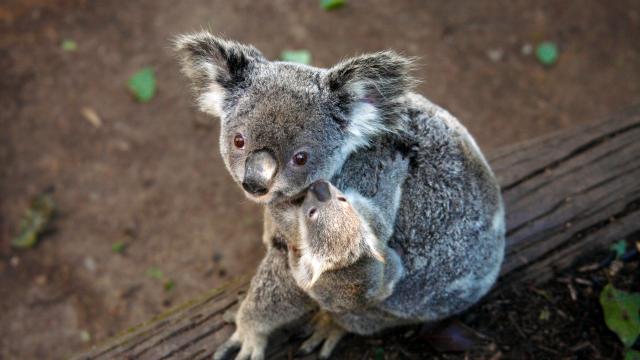Federal Environment Minister Sussan Ley is reportedly poised to decide whether some koala populations should be listed as endangered, as new research shows her government continues to approve land clearing in koala habitat.
Analysis released by the Australian Conservation Foundation (ACF) on Tuesday found that in the decade since koalas were declared vulnerable to extinction, the federal government had approved the clearing of 25,000 hectares of the species’ habitat.
It follows the Morrison government’s announcement last month of A$50 million to restore koala habitat, monitor populations and research the animals’ health.
But until the problems of habitat loss and land clearing are addressed, national koala populations will continue to dwindle. And as our recent research shows, much of the new funding is inadequate at the scale required.
Koala cash-splash
The Threatened Species Scientific Committee, which advises the federal government, has recommended the status of koalas in Queensland, New South Wales and the ACT be upgraded from vulnerable to endangered.
Ley is expected to respond to the recommendation by next month. Listing the koala as endangered would be a serious escalation in its threat status.
The federal government’s recent $50 million of koala funding supports various initiatives. They include:
- $20 million for large habitat and health protection projects delivered by Indigenous groups, industry, state and territory governments and non-government organisations
- $10 million for community-led habitat restoration, health and care facilities, and citizen science projects
- $10 million to extend the National Koala Monitoring Program
- $2 million to fund applied research in koala health
- $1 million to fund vet staff and koala care, treatment and triage.
These are important investments. But we see two major issues with the federal government’s approach.
Habitat loss: the biggest problem
Until koala habitat is protected, conservation efforts – largely funded by the taxpayer – will continue to be undermined.
Other recent federal koala funding includes $24 million after the Black Summer bushfires.
The NSW government wants to double the number of koalas in that state by 2050. To that end, it pledged $193 million over five years in the current budget. This followed the $44.7 million of koala funding it announced in 2018.
All this comes on top of the millions of dollars in international and national community donations for koala conservation efforts after the Black Summer bushfires.
But the primary driver of koala population decline is the clearing of its habitat. No amount of money can save koalas unless we tackle this.
The ACF research released on Tuesday confirmed the extent of the problem. The federal government approved the clearing of 25,000 hectares of koala habitat in the past decade, comprising 63 projects.
Most were mining projects, followed by land transport and housing developments.
Two recent federal decisions demonstrate this active undermining of koala conservation efforts:
- approval to clear more than 75 hectares of critical koala habitat for housing west of Brisbane, reportedly in breach of the government’s own policy
- approval of the Brandy Hill Quarry, which would clear 52 hectares of koala habitat to produce gravel and stone.
These projects were also approved by respective state governments, and were enabled by weak koala protections under both national and state environment laws.
Barely scratches the surface
Second, the federal funding for koala monitoring is inadequate.
We recently modelled the costs of conducting large-scale koala population surveys with methods that could be incorporated into the National Koala Monitoring Program.
We examined the cost of surveying 1.9 million hectares of fire-affected places in NSW considered “high and very high suitability” koala habitat.
We put the price tag at $9.5 million to $11.5 million for on-ground techniques, or about $7 million for efficient and cost-effective drone thermal imaging.
That’s just for one survey round. Even if the 1.9 million hectares was fairly distributed to key sampling areas, which is likely, the surveys must still be repeated at regular intervals to monitor koala populations over time.
The latest funding announcement for the National Koala Monitoring Program brings the total to $12 million since the initiative was announced in 2020. Given the vast extent of the koala’s range across five states and territories, this monitoring funding barely scratches the surface.
The federal government must step up
Koala conservation is largely funded by the taxpayer and koalas receive far more funding than other threatened species.
So it’s only fair to expect this funding to deliver results. To protect the important public and community investment in koalas, the federal government must:
- review current funding levels and provide adequate investment to support all Australia’s wildlife, including koalas
- endorse the expert recommendation to list the koala as endangered in parts of Australia
- finalise the Draft National Recovery Plan for the koala, which has been pending since 2012
- enforce strong protections for koalas and other native wildlife, with independent oversight. The measures should follow the recommendations in Professor Graeme Samuel’s review of federal environment law.
In this, an election year, the Morrison government has the chance to show Australians it’s committed to saving our threatened wildlife. ![]()
Lachlan G. Howell, Research Fellow | Centre for Integrative Ecology, Deakin University; Ryan R. Witt, Postdoctoral Researcher and Honorary Lecturer | School of Environmental and Life Sciences, University of Newcastle, and Shelby A. Ryan, PhD Candidate | School of Environmental and Life Sciences, University of Newcastle
This article is republished from The Conversation under a Creative Commons license. Read the original article.

Leave a Reply
You must be logged in to post a comment.